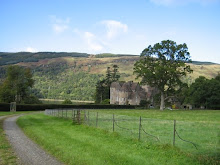Tuesday, January 20, 2009
Music and Society
Thursday, January 15, 2009
Music and Rites
Monday, January 12, 2009
Music and Religion
Cool Stuff
http://www.youtube.com/watch?v=KFjAe2ATizk
Since the movie only gave me a small taste of it, I wanted to see more jingle dancing! I'm not sure which aspect of the dance I enjoy the most: the colors, the synchronized movement, or the shininess! Unfortunately, you cannot really hear the jingle in this vid.
http://www.youtube.com/watch?v=Z2Ewmqr3Odk&feature=related
...and who didn't love that chicken dance? It's amazing how the dancers can truly capture the essence and weirdness that is a chicken, and still have the dance be graceful and beautiful!
http://www.youtube.com/watch?v=PY2bvOPiy08
Music and Movement
Music and movement have been a power couple since the beginning of humanity. Dancing is just as much a means of expressing emotion as speech. Our own bodies pulse to a natural rhythm. We mimick nature through gestures; we describe and react with our hands and faces. Dancing is how my grandparents fell in love.
Some form of expressive movement can be found in every culture throughout the world. Music is a springboard for many forms of artistic communication, and movement, inspired by a throbbing bass line or a jaunty melody, is fundamental to the human condition.
Monday, January 5, 2009
Erhu, are you? (aka A Musical Autobiography)
I did not know whether to feign excitement or admit to my utter clueless when Maeve called me one afternoon, announcing that she was the proud owner of an erhu. She had recently returned from a school excursion to China, and upon declaring her latest procurement, I knew immediately that I was in for an adventure. So, confessing my ignorance, I told her not to reveal the mysterious erhu's identity; that I would pay a visit and see for myself what it was. Maeve is the brainy, musical one of my friends. We actually became friends over a Telemann Duo Sonata, Maeve on flute, myself on violin. We have been playing Irish jigs, Scottish reels, and dreadful Harry Potter arrangements together ever since. We have danced at Gaelic Storm and Chieftans concerts, and composed pieces for recorder quintet (to make use of Maeve's alto recorder). I can always count on her to divulge some random factoid, or introduce me to a genre of music or instrument that I had no idea existed. When I drove over to Maeve's apartment to investigate this erhu, I was surprised to find that it was not one of her usual aerophones (as I had anticipated), but an odd type of chordophone/membranophone hybrid.
It turns out that it is an ancient "Chinese violin". Pronounced "arr-who", It is played by resting the body of the instrument on one's lap, stretching the horsehair bow taut between one's right thumb and index finger, and pulling the hair back and forth between two strings, so close together on the "fingerboard" of the instrument that they touch. The result is a twangy, melancholy sound, not unlike the Western violin. The range between the two instruments is about the same, so it was not hard for my left hand to acclimate to the intervals on the fingerboard. The difficult part was figuring out the right way to maneuver the bow between the strings. I am so used to significantly moving my bow on the viola, moreover the bowhair is on top of the strings; yet it takes only a subtle movement to get the other string of the erhu to sound, and even more unusual (to me) is that the bowhair is actually between the strings!
The erhu was my fascinating discovery of the summer of 2007, thanks to dear Maeve.
